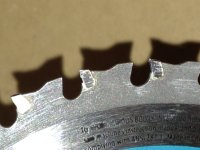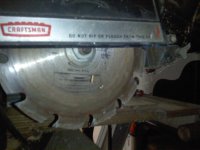We all know common sense isn't as common as it maybe used to be. Sometimes I think a substantial fraction of the remaining common sense in this country is concentrated in the TBN readership. I really appreciate the considered, experience-based comments, especially for this topic, where I know for sure I am pushing the envelope on my own experience.
The blade is obviously the main concern. In coming up with this approach I read a fair amount about other metal cutting saws and blades. Here are the main issues that I identified.
RPM. The Makita 5 3/8 blade is rated at 4600. The DeWalt motor turns at 3425.
Tooth speed. This is a function of RPM and blade diameter. Slower is better for thick mild steel. The range for six of the most commonly available metal saws is 4082 feet/minute (Makita 12" chopsaw) to 7745 feet/minute (Milwaukee 8" skilsaw style). Tooth speed in the Makita/DeWalt application is 4817 feet/min, that is toward the slow end of the range.
Tooth Design. See photo below. The Makita blade uses a carbide tooth that is mechanically locked into the metal blade and also has a very restrictive controlled feed design. And has a lot of negative hook. All three features add to safety.
Binding. I never had the Makita cordless bind, even when cutting 2" x 4" aluminum channel. In the DeWalt application the blade is perfectly square and rigid in relation to the table, so vertical binding is not likely. You can see in the earlier photos that I use a fence on the left side of the cut but not the right side. This eliminates the possibility of horizontal binding.
Self-Feeding. This is a big problem with radial arm saws when used according to manufacturer's directions. That is, if you start the cut with the motor head at the column and pull it toward you through the work. Especially if the saw is the least bit out of adjustment. The blade will try to climb onto the material and jump toward you. This is very demoralizing. After one or two such episodes (30 years ago now), I stopped using the radial arm saw that way. Pushing through wood in the normal (skilsaw) way is much easier and safer. I am sure that goes double for metal.
Heat Buildup. I never experienced this with the Makita cordless including 6" cuts in 1/2" mild steel and 12" cuts in 3/4" aluminum. For intermittent use I don't expect it to be a problem on the radial arm saw.
Specifically on cutting thick stock. The Makita literature, like everything these days, has about 4 pages of "do not" guidance. Apart from specifiying the maximum depth of cut (2"), there is no other reference to material thickness. Clearly it is intended for tubing, light channel, metal roofing, etc. But as others have noted, folks have been using metal blades in skilsaws for thick stock for a number of years.
All things considered, I feel reasonably sure this application is safe for the purposes I intend. Especially with a heavy duty shroud if things go wrong. Will provide an update after the first project, which is cutting out the components of a mechanical thumb for the
B21.



